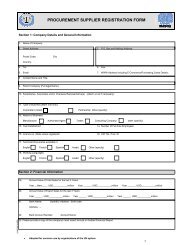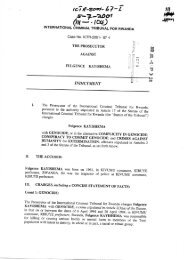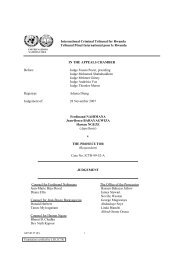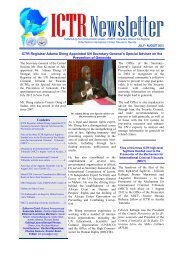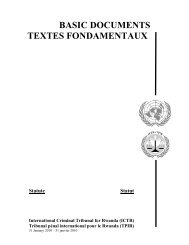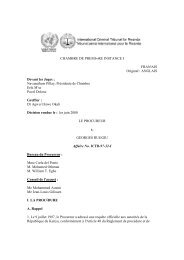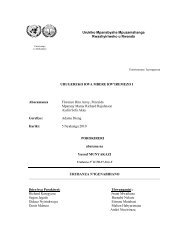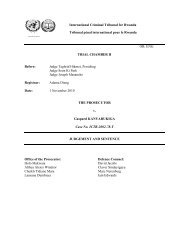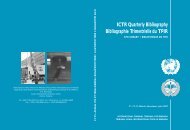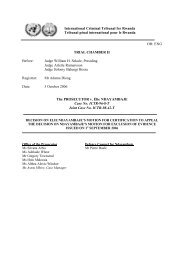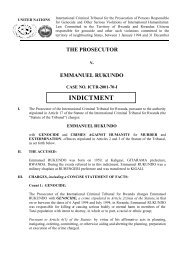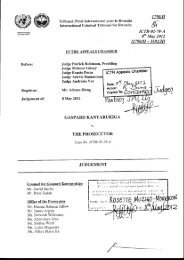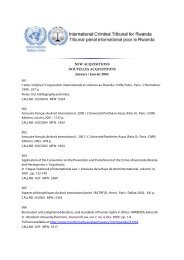Report of Proceedings - International Criminal Tribunal for Rwanda
Report of Proceedings - International Criminal Tribunal for Rwanda
Report of Proceedings - International Criminal Tribunal for Rwanda
You also want an ePaper? Increase the reach of your titles
YUMPU automatically turns print PDFs into web optimized ePapers that Google loves.
Mr. Ngoga began his presentation by discussing the legal situation in <strong>Rwanda</strong> prior to the<br />
genocide. He described <strong>Rwanda</strong> as having a system <strong>of</strong> institutionalised impunity, created by<br />
amnesty laws. In 1959, major massacres in <strong>Rwanda</strong> caused a very big section <strong>of</strong> the population<br />
to flee the country. Soon after, in 1963, an amnesty law was passed that granted amnesty to<br />
everyone involved in the 1959 massacres. There was a second round <strong>of</strong> massacres in 1973.<br />
Tutsi nationals in the higher learning institutions were the main targets. Like be<strong>for</strong>e, an<br />
amnesty law passed in 1974, pardoning all that participated in the violence in 1973. There were<br />
more massacres in 1990 after the invasion <strong>of</strong> <strong>Rwanda</strong> by the RPF. Those who were accused <strong>of</strong><br />
being RPF accomplices were targeted, tortured and killed. Immediately following there was<br />
another amnesty law that pardoned everybody who had participated.<br />
Mr. Ngoga believes that if the genocide had not stopped in 1994, <strong>Rwanda</strong> would currently<br />
have another amnesty law. In addition to the history <strong>of</strong> amnesty laws, the behaviour <strong>of</strong><br />
governments towards international conventions was also another reflection <strong>of</strong> little attention<br />
that was paid to the matters <strong>of</strong> human rights. The Genocide Convention <strong>of</strong> 1948 was ratified by<br />
<strong>Rwanda</strong> but with reservations related to punishment. It was like saying, "We accept and agree<br />
that genocide is a crime, but it does not deserve to be punished." That is clearly on record.<br />
<strong>Rwanda</strong>’s judicial sector was crippled by the 1994 genocide. Be<strong>for</strong>e the genocide, <strong>Rwanda</strong><br />
only had 748 magistrates, 70 prosecutors, and 631 support staff. Appointment to the judicial<br />
sector, whether as a magistrate or a prosecutor, did not require legal training. There<strong>for</strong>e, 90%<br />
<strong>of</strong> those in the judicial system were untrained. After the genocide, <strong>Rwanda</strong> faced a lack <strong>of</strong><br />
human resources in two regards. First, only 244 magistrates and 12 prosecutors survived the<br />
genocide. Second, the majority <strong>of</strong> those who did survive were never properly trained. In<br />
response, the government provided the 244 magistrates with six months <strong>of</strong> training.<br />
<strong>Rwanda</strong> also did not have a law to punish genocide. Although <strong>Rwanda</strong> looked to the<br />
instruments <strong>of</strong> ratification <strong>of</strong> the Genocide Convention, it quickly discovered that it could not<br />
punish the crime <strong>of</strong> genocide under those instruments. In response, the government acted<br />
quickly, enacting a law that could be used to punish the crime <strong>of</strong> genocide. Whether it could<br />
apply retrospectively was another question.<br />
In 1996 <strong>Rwanda</strong> established a system to address the crimes in a classical way. It organised<br />
crimes <strong>of</strong> genocide according to the following four categories: 1) planners and positions <strong>of</strong><br />
authority; 2) notorious killers; 3) sexual torture crimes; 4) looters and other property crimes.<br />
Sentences varied accordingly.<br />
With 120,000 detainees, insufficient evidence, and prison facilities ill equipped to deal with<br />
such vast numbers, the government had to find an additional way to address the crimes. In<br />
response, a confession program, known as the Organic Law, was established. It allowed <strong>for</strong> a<br />
reduction <strong>of</strong> sentence and successfully yielded testimonies that had not come out be<strong>for</strong>e. The<br />
confession programme helped the process go faster. The end <strong>of</strong> 2000 completed Sixty thousand<br />
cases. Almost 60% <strong>of</strong> them involved guilty pleas. There were group confessions and trials<br />
because the genocide was about a group <strong>of</strong> people attacking one person. In some instances,<br />
there were up to 60 people in one trial.<br />
29



